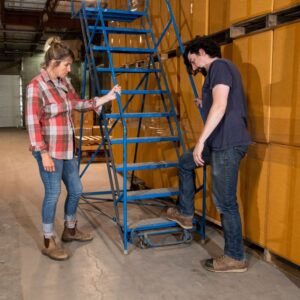Safety in Seven – Quick Tips for Warehouse Safety
Safety in the warehouse is a common topic, and deservedly so. According to the National Safety Council (NSC), there were 2.6 million reported non-fatal workplace injuries in the private sector and a rate of 2.7 per 100 full-time equivalent (FTE) workers. In 2001, transportation accidents were responsible for 1,982 fatalities.

Identify hazards
Take the time to evaluate potential issues and hazards in the warehouse – your workspace and beyond. Keep an eye out for simple slip, trip, and fall hazards. That could be anything from cables left behind or an obstacle sticking out at an awkward angle. Even something as harmless as a dropped pencil can become a slip hazard if someone is rushing past and steps on it.
Issues like cracks and holes in the floor are not just trip hazards, they can also cause issues for machinery. For example, they can damage forklifts or harm a worker.
Safety training
Training, training, training! Pay attention during your training and ask questions if you have them. If you are unsure about a machine that you’ve been asked to use, speak up! The less you know, the more likely you are to make mistakes, which can lead to dangerous situations.

Storage
Improper storage can not only damage the stock but also harm employees and equipment. Follow the storage rules at your workplace to ensure that items are placed properly and safely. Don’t stack shelves too high, keep stacks neat and smaller. That makes items easier and safer to retrieve. Always practice the correct lifting techniques to avoid injury to yourself or damage to items.
Cleanliness
Taking shortcuts can lead to injuries and damaged items and equipment. Leaving a pile of trash “for later” can mean a slip-and-fall accident for a fellow employee. Stop what you’re doing and clean up messes as they happen. Whether packing or unpacking boxes or delivering them within the warehouse, keeping a clear and clean space benefits everyone.

Personal protective equipment
Personal protective equipment (PPE) is a crucial step in safety. Use the appropriate equipment for the particular task you are working on. Most of us are familiar with hard hats and safety goggles as important, but remember that there is other equipment for specific tasks, like high visibility jackets, for example.
Inspection
Your supervisors likely inspect the warehouse throughout the workday. However, you can do your part by reporting faulty equipment that needs repair, or that seems “off.” Don’t wait for something dangerous to happen – let your supervisor know! This includes everything from equipment to shelving and flooring – anything that can cause damage or harm.
Communicate, communicate, communicate!
As previously mentioned, keep an open line of communication with your coworkers and supervisors. Safety is everyone’s job and sometimes, you may feel like you take it more seriously than others. Lifesaving measures are disaster prevention. From understanding how the warehouse works and being trained to use the equipment to keeping a clean workplace and obeying safety rules, you will help to keep yourself and your coworkers safe.
Learn more about this topic from OSHA.
Find out how A.R.M. can help you and your company – from safety training to staffing, HR services, and more!

